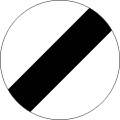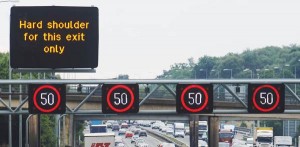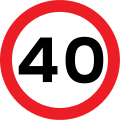Speed Limits
At 4front Driving School we encourage our students to be observant towards speed limit signs and look out for the change of speed which is more likely to be placed at the junction to a new road, but can also appear at points on a long carriageway too.
National Speed Limit
 This sign indicates that the national speed limit applies, which is for cars 60mph on a single carriageway or 70mph on a dual carriageway or motorway. It doesn’t necessarily mean that the road is safe to do 60mph or 70mph all the times – there may be sharp bends and other challenging sections, especially on a single carriageway road. Therefore you as a driver have a responsibility to judge the safest speed to suit the road and the driving conditions.
This sign indicates that the national speed limit applies, which is for cars 60mph on a single carriageway or 70mph on a dual carriageway or motorway. It doesn’t necessarily mean that the road is safe to do 60mph or 70mph all the times – there may be sharp bends and other challenging sections, especially on a single carriageway road. Therefore you as a driver have a responsibility to judge the safest speed to suit the road and the driving conditions. To begin with when learning to drive we say to our learners to drive at a speed they feel comfortable with. Once you have built up your confidence you can aim towards achieving a safe speed to drive at. Remember it can also be dangerous driving to slow. There is no excuse for dangerous driving wheather it be too fast or too slow.
Maximum Speed
Gantries across motorways
 Gantries across motorways can warn you of temporary or variable speed limits and where a hard shoulder is open or closed as well as lane closures. These are found on smart motorways. These speed limits must be obeyed and can be controlled centrally to take into account other factors such as traffic volumes, weather, accidents, etc. You will find regular speed cameras or average speed cameras associated with gantries.
Gantries across motorways can warn you of temporary or variable speed limits and where a hard shoulder is open or closed as well as lane closures. These are found on smart motorways. These speed limits must be obeyed and can be controlled centrally to take into account other factors such as traffic volumes, weather, accidents, etc. You will find regular speed cameras or average speed cameras associated with gantries. Basic Speed Limit Signs
 The basic speed limit sign, is a red circle with a black number contained within it. You may see signs as low as 5mph. when a speed limit changes then you are expected to reduce your speed before you reach the sign.
The basic speed limit sign, is a red circle with a black number contained within it. You may see signs as low as 5mph. when a speed limit changes then you are expected to reduce your speed before you reach the sign.If you are driving around a town and there are no signs then the speed limit is 30mph. If the speed limit goes from 40-30 or any other speed to 30 then you will see the change of speed as a 30mph sign. This usually appears at at junction into a new road or exit on a roundabout.
If you are interested in learning to drive then please call Simon at 4front Driving School on 07905657229
Or visit our website on http://www.4frontdrivingschool.co.uk
You can email 4frontdrivingschool@gmail.com
Or visit our Facebook Page at http://www.facebook.com/4frontdrivingschool
